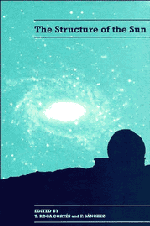Book contents
- Frontmatter
- Contents
- List of participants
- Group photo
- Preface
- TECHNIQUES FOR OBSERVING SOLAR OSCILLATIONS
- TESTING A SOLAR MODEL: THE FORWARD PROBLEM
- TESTING SOLAR MODELS: THE INVERSE PROBLEM
- GLOBAL CHANGES IN THE SUN
- SOLAR INTERIOR AND SOLAR NEUTRINOS
- THE SOLAR MAGNETIC FIELD
- ACTIVITY IN THE SOLAR ATMOSPHERE AS OBSERVED BY YOHKOH
TESTING A SOLAR MODEL: THE FORWARD PROBLEM
Published online by Cambridge University Press: 05 October 2010
- Frontmatter
- Contents
- List of participants
- Group photo
- Preface
- TECHNIQUES FOR OBSERVING SOLAR OSCILLATIONS
- TESTING A SOLAR MODEL: THE FORWARD PROBLEM
- TESTING SOLAR MODELS: THE INVERSE PROBLEM
- GLOBAL CHANGES IN THE SUN
- SOLAR INTERIOR AND SOLAR NEUTRINOS
- THE SOLAR MAGNETIC FIELD
- ACTIVITY IN THE SOLAR ATMOSPHERE AS OBSERVED BY YOHKOH
Summary
INTRODUCTION
The present chapter addresses the forward problem, i.e., the relation between the structure of a solar model and the corresponding frequencies. As important, however, is the extent to which the frequencies reflect the physics and other assumptions underlying the model calculation. Thus in Section 2 I consider some aspects of solar model computation. In addition, the understanding of the diagnostic potential of the frequencies requires information about the properties of the oscillations, which is provided in Section 3. Section 4 investigates the relation between the properties of solar structure and the oscillations by considering several examples of modifications to the solar models and their effects on the frequencies, while Section 5 considers further analyses of the observed frequencies. Finally, the prospects of extending this type of work to other stars are addressed in Section 6.
A more detailed background on the theory of solar oscillations was given, for example, by Christensen-Dalsgaard & Berthomieu (1991), Gough (1993), and Christensen-Dalsgaard (1994). For other general presentations of the properties of solar and stellar oscillations see, e.g., Unno et al. (1989) and Gough & Toomre (1991).
A little history
The realization that observed frequencies of solar oscillation might provide information about the solar interior goes back at least two decades. Observations of fluctuations in the solar limb intensity (Hill & Stebbins 1975; Hill, Stebbins & Brown 1976), and the claimed detection of a Doppler velocity oscillation with a period close to 160 minutes (Brookes, Isaak & van der Raay 1976; Severny, Kotov & Tsap 1976) provided early indications that global solar oscillations might be detectable and led to the first comparisons of the reported frequencies with those of solar models (e.g. Scuflaire et al. 1975; Christensen-Dalsgaard & Gough 1976; Iben & Mahaffy 1976; Rouse 1977).
Information
- Type
- Chapter
- Information
- The Structure of the Sun , pp. 47 - 140Publisher: Cambridge University PressPrint publication year: 1996
Accessibility standard: Unknown
Why this information is here
This section outlines the accessibility features of this content - including support for screen readers, full keyboard navigation and high-contrast display options. This may not be relevant for you.Accessibility Information
- 20
- Cited by
